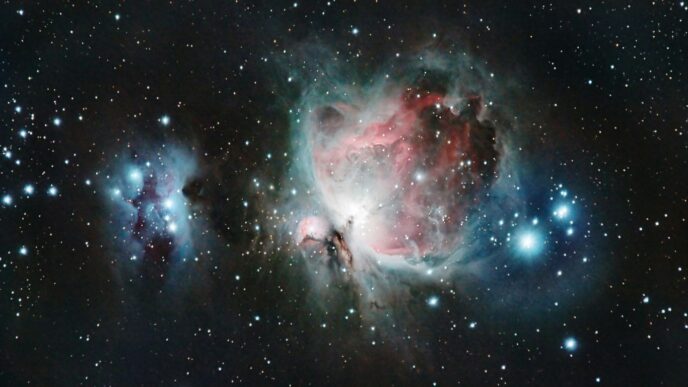Hey everyone, get ready! 2025 is going to be a pretty big year for checking out Mars. The Red Planet will be at its closest point to Earth, making it a prime time for observations. Whether you’re a seasoned stargazer or just curious, this guide will help you get the most out of seeing 2025 Mars. We’ll talk about what to look for and how to get the best views.
Key Takeaways
- 2025 Mars will be closest to Earth around January 15-16, 2025, making it the best time to see it.
- You’ll need a telescope to see details on 2025 Mars, and color filters can help bring out more features.
- For the clearest views of 2025 Mars, pick nights with still air and let your telescope adjust to the outside temperature.
- You might see dark and light areas, polar caps, or even clouds and hazes on 2025 Mars.
- Observing 2025 Mars takes some practice, but looking at it often will help you get better at spotting things.
The 2025 Mars Opposition
Mars is a fascinating planet to observe, but it can be tricky. It only gets close enough to Earth for good viewing every couple of years. The 2025 opposition presents a great opportunity to see the Red Planet in detail. Let’s explore what makes this event special.
Understanding Opposition for 2025 Mars
Mars opposition happens when Earth passes between the Sun and Mars. This alignment makes Mars appear brighter and larger in our night sky. It’s the best time to observe the planet because it’s at its closest point to us. The 2025 opposition occurs around January 15-16. While not the closest possible opposition, it’s still a good one. Mark your calendars!
Apparent Size of 2025 Mars
During the 2025 opposition, Mars will appear larger than usual, but not as large as in some past oppositions. The apparent size of a planet is measured in arcseconds. At its last opposition in December 2022, Mars reached 17.2 arcseconds at closest approach, but in 2020 it was 22.6. For the 2025 opposition, Mars will reach an apparent size of 14.6". This is still large enough to reveal surface details with a decent telescope. Remember that atmospheric conditions also play a big role in how well you can see those details. You can use binoculars to observe Mars traversing the Beehive Cluster in May 2025.
Tracking 2025 Mars Brightness
Near opposition, Mars shines brightly in the night sky. It will have a distinct red-orange color, making it easy to spot. At this opposition, the planet grows to a brightness of magnitude -1.3, much brighter than any star (except for Sirius) and outshone only by the Moon and Jupiter, and shines with a steady ochre-colored glow. Keep an eye on its brightness as it approaches and recedes from opposition. You’ll notice it gradually getting brighter, then dimmer again. This change in brightness is a clear indicator of Earth’s changing distance from Mars.
Essential Tools for 2025 Mars Observation
Alright, so you’re gearing up to observe Mars in 2025? Awesome! You’ll need the right tools to make the most of it. Let’s talk about what you’ll need to get the best views of the Red Planet.
Selecting the Right Telescope for 2025 Mars
First off, you’re gonna need a telescope. I mean, duh, right? But not just any telescope will do. For Mars, you want something with decent aperture and focal length. A small telescope is better than nothing, and even a 60mm to 80mm scope can show some surface features on a night with good seeing. But if you’re serious about seeing details, you’ll want something bigger. Think about a Schmidt-Cassegrain or Maksutov-Cassegrain telescope; they pack a long focal length into a manageable size. A good-quality refractor could also work, potentially showing cloud structure. Newtonian reflectors are another option, offering longer focal lengths to get you closer. Consider your budget and how easy the telescope is to move around. The Celestron Inspire 100AZ is a great starting point.
Optimizing Eyepieces for 2025 Mars Views
Next up: eyepieces. You’ll want a few different ones to play around with magnification. Start with a low-power eyepiece to find Mars, then crank up the magnification until the view starts to get blurry. The highest usable magnification depends on the seeing conditions and the size of your telescope. Lower-power eyepieces are generally easier to look through. It’s worth noting that refractors are likely to need high-powered eyepieces and a Barlow lens to get detail.
Utilizing Color Filters for 2025 Mars
Don’t underestimate the power of color filters! These screw onto the base of your eyepiece and can really boost contrast on Mars. Here’s a quick rundown:
- Orange: A good starting point. It helps to neutralize the orange color of Mars, making darker regions stand out.
- Red: Maximizes contrast of surface features and enhances fine details.
- Blue/Deep Blue: Shows atmospheric clouds and limb hazes.
- Light Green: Darkens red and blue features, enhancing frost patches.
- Yellow: Brightens desert regions and darkens bluish features.
| Filter Color | Effect |
|---|---|
| Red | Enhances surface details, dust cloud boundaries, polar cap boundaries |
| Blue | Shows atmospheric clouds, limb hazes |
| Light Green | Enhances frost patches, surface fogs, polar caps |
| Orange | Increases contrast, penetrates hazes |
| Yellow | Brightens desert regions, darkens bluish features |
An orange filter is a good start as it neutralizes the orange disc, allowing dark regions to stand out.
Maximizing Your 2025 Mars Viewing Experience
Observing Near Opposition for 2025 Mars
To really make the most of the 2025 Mars opposition, timing is everything. Mars will appear largest and brightest in the weeks surrounding its opposition. Trying to observe too far outside this window means you’ll be looking at a smaller, dimmer disc, making it harder to spot those cool surface details. Think of it like this: you wouldn’t try to watch a movie on your phone from across the room, would you? Same principle applies here. Get your telescope ready around opposition for the best views.
Choosing Nights with Steady Air for 2025 Mars
Seeing conditions can make or break your Mars observing session. What does that mean? Well, it’s all about how steady the air is. Turbulent air messes with the image, making Mars look like a wobbly, blurry mess. You want nights where the stars aren’t twinkling like crazy. Sometimes, a little bit of haze can actually help steady the air. On nights with bad seeing, Mars will just look like an orange blob. But on a night with excellent seeing, you’ll be amazed at the details you can pick out. It’s worth checking the weather forecast, specifically looking for seeing reports, before you head out.
Acclimatizing Your Telescope for 2025 Mars
Don’t underestimate the importance of letting your telescope adjust to the outside temperature. If you drag your warm telescope straight outside into the cold night air, you’re going to have problems. Temperature differences create air currents inside the telescope tube, which will blur the image. Give your scope at least 30-60 minutes to cool down before you start observing. Bigger telescopes, especially those with closed tubes, need even longer. It’s a bit like letting a hot cup of coffee cool down before you try to drink it – patience is key. This is especially important for getting a good view of the Red Planet.
What to Expect on the Surface of 2025 Mars
Observing Mars is a rewarding challenge. It’s not as easy as spotting Jupiter or Saturn, but the surface details you can glimpse make it worthwhile. Let’s talk about what you might see in 2025.
Identifying Surface Details on 2025 Mars
The key to successful Mars observing is knowing what to look for and when. Mars has a rusty, dusty surface, and the contrast between light and dark areas can be subtle. You’ll want to familiarize yourself with the major features.
Some prominent features to keep an eye out for include:
- Syrtis Major: A dark, arrow-shaped region. It’s usually one of the easiest features to spot.
- Mare Tyrrhenum, Mare Erythraeum, and Mare Sirenum: These are other dark regions in the southern hemisphere. They might appear as diffuse smudges.
- Hellas Planitia: A large, circular, reddish-orange basin. It can sometimes appear quite bright.
It’s also worth noting the polar caps. They shrink and grow with the Martian seasons. The southern cap is usually more prominent. Remember to check out Sky This Month for the latest information.
Spotting Atmospheric Phenomena on 2025 Mars
Mars has an atmosphere, albeit a thin one, and this leads to some interesting phenomena. Dust storms are probably the most dramatic. They can be local or even global, obscuring surface features for weeks. Keep an eye out for bright clouds, especially near the limb (edge) of the planet. These are often water ice clouds, similar to cirrus clouds on Earth. Also, look for limb hazes, which can appear as a brightening near the edge of the planet’s disk. Color filters can really help with this. For example, blue filters can highlight atmospheric clouds. Here’s a quick reference:
- White or Blue Clouds: Water ice clouds, best seen with blue filters.
- Yellowish Haze: Dust in the atmosphere, can obscure surface details.
- Polar Hoods: Clouds that form over the polar regions.
Using the Mars Profiler for 2025 Mars
Knowing which side of Mars is facing Earth is super important. The Mars profiler from Sky and Telescope is a great tool. It shows you a map of Mars for any given date and time, so you can see which features are visible. It’s really useful for planning your observing sessions. Mars rotates a bit slower than Earth, so features will appear to drift across the disk from night to night. It takes Mars about 24 hours and 37 minutes to complete one rotation. This means that features will appear about 37 minutes later each night. So, if you see Syrtis Major at 10:00 PM one night, it will be visible around 10:37 PM the next night. This is something to keep in mind when you’re observing frequently.
Overcoming Challenges in 2025 Mars Observation
Observing Mars, while rewarding, isn’t always a walk in the park. The Red Planet presents a few unique hurdles that can test even seasoned stargazers. But don’t worry, with a little know-how, you can overcome these challenges and get some amazing views during the 2025 opposition.
Dealing with Atmospheric Distortions for 2025 Mars
Earth’s atmosphere can be a real pain when trying to observe Mars. It’s like looking through a wavy window – the image shimmers and blurs, making it hard to see details. This effect, known as seeing, is caused by air turbulence. Here’s what you can do:
- Choose nights with steady air: Keep an eye on weather forecasts that specifically mention seeing conditions. Nights with less wind and stable air are your best bet.
- Observe from a dark location: Light pollution can worsen the effects of atmospheric distortion. Get as far away from city lights as possible.
- Be patient: Sometimes, the atmosphere will calm down for brief periods. Keep observing, and you might catch a moment of clarity.
Managing the Brightness of 2025 Mars
When Mars is at opposition, it can be surprisingly bright. This can make it difficult to see subtle surface details. It’s like trying to read a book under a spotlight – the glare washes everything out. Here’s how to deal with it:
- Use a neutral density filter: These filters reduce the overall brightness of the planet without affecting the color balance. They’re like sunglasses for your telescope.
- Observe at higher magnification: Spreading the light over a larger area can make the image less intense.
- Give your eyes time to adjust: Spend at least 20-30 minutes in the dark before observing to maximize your eye’s sensitivity. This is especially important for M-MATISSE and other missions.
Practicing Your Observing Skills for 2025 Mars
Let’s be honest, seeing details on Mars takes practice. It’s not something you’ll master overnight. The more you observe, the better you’ll become at picking out subtle features. Think of it like learning to play a musical instrument – the more you practice, the better you get. Here’s how to hone your skills:
- Start with low magnification: Get a feel for the overall shape and color of the planet before zooming in.
- Sketch what you see: This forces you to pay close attention to the details and helps you remember what you’ve observed.
- Compare your observations to images and maps: This will help you identify different surface features and track changes over time.
- Observe frequently: Mars rotates, so you’ll see different sides of the planet on different nights. The Mars profiler is a great tool to help you find out which surface features are visible each night.
The Visual Journey of 2025 Mars

Witnessing the Red-Orange Hue of 2025 Mars
When you finally get Mars in your sights, the first thing that grabs you is the color. It’s not just ‘red,’ it’s a deep, rusty, almost otherworldly red-orange. This distinctive color comes from the iron oxide – basically, rust – that’s all over the Martian surface. The intensity of this hue can vary depending on atmospheric conditions and dust storms, so each viewing session offers a slightly different experience. It’s a reminder that you’re looking at a planet with a very different composition than our own.
Tracking the Motion of 2025 Mars
Mars rotates at almost the same rate as Earth, a day on Mars is about 24 hours and 37 minutes. This means that if you observe Mars over several nights, you’ll notice different surface features coming into view. It’s like watching the planet slowly turn, revealing its secrets bit by bit. The effect is that Mars makes a full backward revolution in about 40 days. To help you plan your observations, here’s a rough guide to what you might see:
- Night 1: Key feature A is prominent.
- Night 2: Key feature A is slightly to the west, Key feature B is emerging.
- Night 3: Key feature B is now central, Key feature C is visible on the eastern limb.
Experiencing the Unforgettable View of 2025 Mars
Let’s be honest, Mars can be a tough planet to observe. It’s small, and atmospheric conditions can be a real pain. But when everything comes together – the equipment is dialed in, the air is steady, and Mars is at its brightest – the view can be truly unforgettable. Seeing surface details like the polar ice caps or dark markings is a reward for patience and persistence. It’s a moment where you feel connected to another world, light years away. It’s worth the effort to get the best view of this remarkable world. It’s a reminder of how amazing the universe is, and how much there is to explore. It’s a view that sticks with you long after you’ve packed up your telescope.
Advanced Techniques for 2025 Mars Observers
Enhancing Contrast with Filters for 2025 Mars
Using filters is a great way to bring out more detail when observing Mars. Different colored filters highlight specific features on the Martian surface and in its atmosphere. For example, a red filter can help sharpen the contrast of surface details, while a blue filter can make clouds and hazes more visible. Experimenting with different filters can really improve your viewing experience. An orange filter is a good starting point, as it helps to neutralize the planet’s natural orange hue, allowing darker regions to stand out more clearly. It’s a simple trick that can make a big difference.
Penetrating Hazes and Clouds on 2025 Mars
Mars can sometimes be shrouded in dust storms or covered by clouds, making surface observation difficult. Certain filters can help you see through these atmospheric obstructions. A red or orange filter is often effective at penetrating dust, while a blue filter can sometimes help to reveal cloud formations. Also, consider the atmospheric conditions. Nights with a bit of haze can sometimes offer steadier air than crystal-clear nights, which can actually improve your overall viewing. It’s all about finding the right balance and using the right tools to cut through the haze.
Observing Frequently for Full 2025 Mars Rotation
Mars rotates on its axis roughly every 24 hours and 37 minutes, which is pretty similar to Earth’s rotation. This means that by observing Mars regularly, you can see its entire surface over a period of several weeks. Consistent observation allows you to track changes in Martian weather patterns and the appearance of surface features as they rotate into view. The top tech stocks are not the only thing that rotates! To help plan your observations, use tools like the Mars Profiler from Sky and Telescope to determine which surface features will be visible on a given night. This helps you make the most of each viewing session and build a complete picture of the Red Planet.
Here’s a simple schedule to maximize your observations:
- Plan Ahead: Check the Mars Profiler to see which features are facing Earth.
- Observe Regularly: Try to observe every few nights to catch different parts of the planet.
- Keep Notes: Record what you see, including any changes or interesting features. This helps you track the planet’s rotation and any atmospheric events.
Wrapping Things Up: Your Mars Adventure Awaits!
So, there you have it. Observing Mars in 2025 is going to be a real treat, even if it’s a bit smaller than last time. It’s not like looking at Jupiter or Saturn, which are pretty easy to spot. Mars needs a little more effort, a bit of practice, and definitely the right tools. But trust me, when you finally catch a clear view of those surface features, maybe even a dust storm, it’s totally worth it. It’s a unique experience, seeing another world with your own eyes. So get your gear ready, find a good spot, and enjoy the show. Happy stargazing!
Frequently Asked Questions
When is the best time to see Mars in 2025?
Mars is easiest to see when it’s closest to Earth, which happens about every two years. This event is called “opposition.” In 2025, Mars will be at its closest around January 15-16. This is when it looks biggest and brightest in the sky.
Do I need a special telescope to see Mars?
You can spot Mars with just your eyes! It will look like a bright, reddish-orange star. For a better view, binoculars can make it brighter. But to see details on its surface, you’ll need a telescope.
Can color filters help me see Mars better?
Yes, color filters can help! Red filters make surface features stand out more. Blue filters help you see clouds and haze in Mars’s atmosphere. Orange and yellow filters can also improve contrast.
Why is Mars sometimes hard to see clearly through a telescope?
Even with a good telescope, Mars can be tricky to observe. Earth’s air can make it look blurry, and Mars itself is quite small. It takes practice and patience to see its details clearly.
Will Mars always look the same when I observe it?
Mars spins pretty fast, completing a turn in just over 24 hours. This means if you observe it over several hours, or on different nights at the same time, you’ll see different parts of its surface. There are tools online, like a “Mars profiler,” that can show you which side of Mars will be facing Earth on any given night.
What kinds of things can I expect to see on Mars’s surface?
You might see dark and light patches, which are different types of rock and dust on its surface. Sometimes, you can even spot polar ice caps or clouds. Occasionally, large dust storms can cover parts of the planet, changing its appearance.














